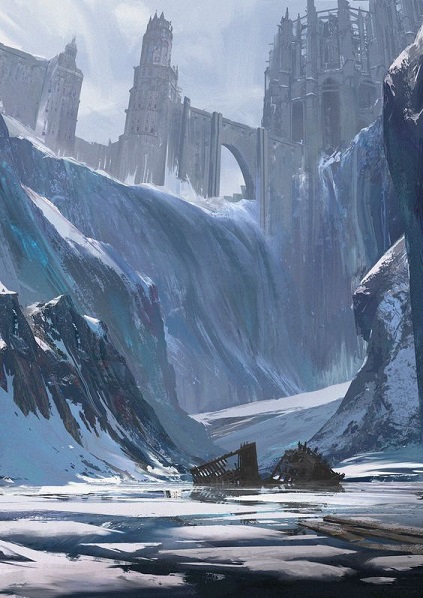
| Category | Cities | ||||||||||||
| Continent | Brucrumus | ||||||||||||
| Region | Aerie of Dragons | ||||||||||||
| Alias | Okaaz Spiir, Heel of Hiznaar Goz | ||||||||||||
| Owner | Oathundor | ||||||||||||
| Population | |||||||||||||
| Races |
| ||||||||||||
| Founded | 29 Lunar 980 HE | ||||||||||||
| Map | Hiznaar Goz |
Okaaz Spiir, Draconic for Sea Spray, is sited on the towering cliffs of Hokzii Rotmindol. In 980 HE, the Zeymah'kein built this coastal watch tower. It overlooked the bay of Nahkropiik Vaal to the south and watched for giant activity in the hills of Gorahrigir.
Anchored on the edge of a fjord, its builders never intended this area to become a great port. Not a naval power, Zeymah'kein built Okaaz Spiir as means of curtaling raids up the nearby fjords. An unexpected twist in the settlement's history, thanks to agents of Primus, is that it became a trading post for raider plunder. You could buy it from the raiders, mark it up to real costs in Zeymah'kein's northern cities, making huge profits.
In Zeymah'kein's final months, Okaaz Spiir fell to Gorahrigir's hill giants. The giant's claim over the city was contested by the Mir'piamauza Empire, victor of the Last Burn (1577 HE - 1600 HE). They claimed all of Akhosia's former lands, holds, and peoples were by the rule of war, property of the conquerors. Instead of all-out war against a place that had resisted numerous attacks, "the Heel of Hiznaar Goz", they took the approach of destabilization, creating dissension in peoples long known for tribal allegiances.
Mir'piamauza's goal of bringing this city into their empire did not succeed. The Mir'piamauza Civil War (1608 HE - 1612 HE) led to Irthorn and many other Mir'piamauza and Zeymah'kein holds becoming independent.
By 1700 HE, Irthorn was a shell of its former greatness. Most of its buildings were burned out, wild beasts and marauders roamed freely through streets clogged with debris and vegetation. For the next two hundred years, it was a ruin, refuge for various giant hunting parties, bandits, and other things foul.
Around the Year 100, hill giants started rebuilding. They secured the area, driving off the bandits and monsters that once roamed freely. With security, the old markets were reopened, brining in people to reoccupy buildings long abandoned. Kriistvrii, many with lineage tracing back to families that once lived here, returned, adding their laws and customs which more than another other, created law and order, spurring civilization and the rise of Irthorn as a great market and anchorage.
By the Year 900, Irthorn had become a powerful city-state with three great harbors, one south of the city facing the bay, and two north facing into the fjords. These harbors came as a result of the growing commercial rivalry between Irthorn and their kinsmen at Thithak. They competed for trade with Sourm-Gar and other Tragaran holds on the southern side of the Sea of Mourning. There is a lot of debate on who has the better harbors, something that has led to many fights in the harbor's rowdy mead halls. It is generally said that Irthorn has the better protected harbors where a pilot is needed to port in the fjord, while those of Thithank are easier to navigate and with cheaper docking fees.
Irthorn's harbors are home ports for many giant-sized ships. The most well-known are the Grimsuvelth Trawlers. Travel up the fjords to others smaller settlements is often done on great ferries. Those abandoned from wear, often become homes, or are turned into camps for the city's poor. These river homes stretch for many miles along the fjord; and every year at least a dozen are lost in cooking fires.
In 1472, Irthorn became the capital of the newly established Kingdom of Oathundor.
The giants of Irthorn, those of Oathundor, are not the type that come down out of the mountains to steal your grain and livestock, or plunder your villages and towns, no they are just as civilized as we goblins that have taken to Irthorn's mercantile fervor. There is something about this place, you get caught up in making deals. One of the market's wise-men, an old grizzled half-devil, claims that it is the work of Primus, he pointed to the merchant stalls and their shrewd dealers and buyers, they all follow his creed - "Keep busy, trade fair and often, think of your next enterprise, keep your mind clear of Chaos's tendrils."
- Snakeye, from his book A Goblin in Irthorn - "Always Trading"
Notable Areas
- Dragons Anchor (forge)
- Kamoni High Road
| Zeymah'kein | ||
| Irthorn | ||
| Thithak | ||
| Oathundor |